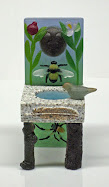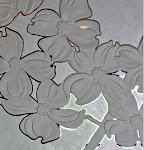Well,
I guess it's back to work stuff. Almost four years ago a friend gave
me a ball mill.
A ball mill, for those that don't know, is a device
that turns glass chunks into powder. It consists of a heavy ceramic
canister half filled with ceramic marbles that turns on the rods
powered by the motor. The ceramic marbles spin and fall much like
clothes in a dryer and this action crushes whatever material you put
in the canister. Ceramists use them to powder and compound materials
to make their own glazes. I thought I could use it to make frit
(crushed glass about the consistency of coarse sand) from the chunks
of lead crystal Gaffer glass that I have that I bought probably 10
years or longer ago.
The
glass we use for our castings is Bullseye which is a soda lime glass.
Soda lime glass is harder and stiffer than lead crystal. Lead
crystal is softer and flows easier and at lower temperatures with
shorter hold times. Casting at higher temperatures and with longer
hold times can be tricky as the glass and mold material want to
become one and then you get a scummy surface.
So,
lesson over, all those years ago I bought a pound each of 15
different colors of Gaffer lead crystal which is a beautiful glass.
It comes in frit and billets (thick slabs) for casting so I ordered
mine in frit which is what I use to fill my molds. Unfortunately for
me, their frit is not uniform in size and each bag contained glass
from powder all the way up to big chunks. I sifted out all the fine
particles of each color and used those to do a small smooth sided
bowl and put the rest of the glass aside. Gaffer will only frit the
glass to a consistent particle size if I order a minimum of
40 pounds per color. So ended my short foray into using Gaffer lead
crystal for my pate de verre.
The
other day I decided to pull out the ball mill and see if I could use
it to frit the glass by stopping the process and sifting out the fine
particles before they were turned to powder. I only use powdered
glass sparingly in my castings because it makes the pieces come out
more opaque.
Whoever
had given the ball mill to my friend, who had it for years before he
gave it to me, did not clean out the canisters before passing it on
and there was residue caked on the sides, bottom, and thickly in the
shoulders of the canisters and it was hard. as. a. rock!
It took me
about 3 hours to scrape and dig and chisel that stuff out of one of
the two canisters and that was after filling it with water and letting it soak
overnight. Then I had to clean each and every marble because they
also had whatever this white powder stuff is caked into the ridges of
the marbles.
Finally
I was ready to try out the ball mill. I selected a color that was in
big chunks and one that I rarely use in case I totally screwed it up (or it gets contaminated) and set it to working. I figured I would give it 30 minutes or so
and then stop it and see what I had.
What
I had was a mixture of the big chunks...and powder. If I wanted to
go to all the trouble to stop it every 20 minutes or so and sieve out
the maybe 1/8 teaspoon of fine particles that might be mixed
in there, then I might get enough fine frit to do nothing
with.
So I'm just going to mill it all down to powder (since that's
my only choice) and then do a piece or two with the powder and see
what I get. Who knows? I may really like it.


















This is so interesting and something I know very little about. I have grown to appreciate much more the work artists do with glass! Such fine tuning and such patience.
ReplyDeleteHaul it out? It looks heavy!
ReplyDeleteWhat fun! I always just wanted to have a rock tumbler to polish..things.
Please show what you get after you use it, what it can do to a piece, because that is a beautiful amber color.
Since I know next to nothing about glass production, I find your explanations extremely interesting.
ReplyDeleteI am looking forward to see the finished product.
ReplyDeleteI had a home that had a bunch of different sieves out in the garage that were to use for glazes.i like this mill, hope it works well for you
ReplyDeleteGood Lord! Woman- you amaze me.
ReplyDeleteThis may be the beginning of a good story.
ReplyDeleteWow, you have a ball mill! I'm impressed. I know this machine as a "want" when I was looking into breaking down bottles. Thanks for the lesson.
ReplyDeleteit all looks delicious...I would have a nice cup of tea with that
ReplyDeleteI don't know a thing about any of this. I was surprised that the marbles are made of a ceramic material. Somehow, I would have assumed the marbles would be softer than the glass, and that everything would end up as powder. Clearly, that's not so. I'm looking forward to seeing how this progresses.
ReplyDeleteI have an English miniature oil lamp that's rose glass with what they call a clear "overshot." I suspect they make that glass shot in somewhat the same way.
Interesting to see into the mechanics of your glass-making. I like your experimental approach! It's pretty fun to try things and see how they come out -- I do the same with photos, although in these post-film days there's not much financial risk.
ReplyDelete